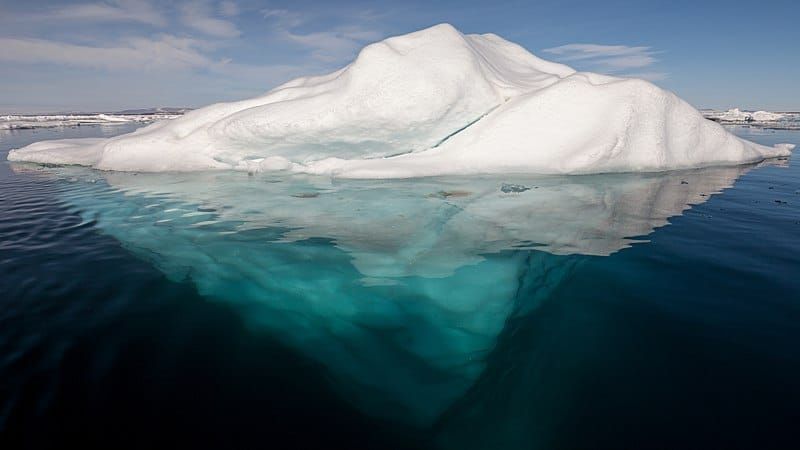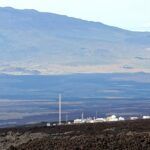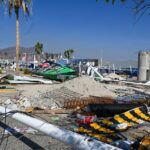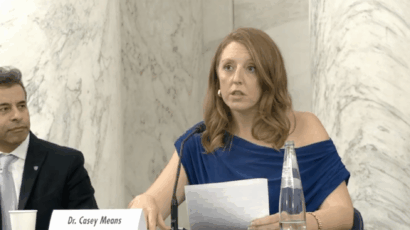How to save the Arctic’s moderating role on global warming
By Durwood J. Zaelke | April 1, 2019

The Arctic plays a critical role in maintaining a safe and stable global climate, with its reflective sea ice that sends significant incoming solar radiation safely back to space and its permanently frozen tundra that secures ancient stores of carbon dioxide and methane.
But the Arctic is warming at twice the global average, threatening to break what may be the weakest link in the chain of climate protection. The amplified Arctic warming is causing the reflective sea ice to melt, exposing darker water that absorbs more incoming solar radiation. It also is causing permafrost to thaw, releasing carbon dioxide and methane. Both processes are self-reinforcing feedback loops, in which initial warming feeds upon itself to cause still more warming. Feeding warming and making it stronger is not a strategy for success.
The recent UN Arctic report synthesizes existing research to show that even if climate emissions were halted today, Arctic warming would continue for at least two decades. This is due to past and present emissions and the return of heat stored in the ocean, where 90 percent of the warming we’ve caused ends up. Of course emissions are continuing.
Fast mitigation at scale can still slow future Arctic warming, starting with immediate cuts to the short-lived climate pollutants—black carbon, methane, tropospheric ozone, and hydrofluorocarbons. Cutting emissions of these short-lived pollutants immediately can reduce the rate of Arctic warming by up to two-thirds. Fast cuts to carbon dioxide also are important, but over the next two decades they will actually add warming. This is because co-emitted cooling aerosols from fossil fuels like coal wash out of the atmosphere in days to weeks and unmask existing warming, while much of the carbon dioxide remains in the atmosphere for hundreds of years to continue causing warming.
Even with fast and dramatic cuts to short-lived pollutants, the race to save the safety functions of the Arctic will now be difficult. For starters, the Arctic is projected to become ice free in the summer months within 15 years, with an uncertainty range of plus or minus 10 years, so perhaps as soon at five years, or if we’re unusually lucky, perhaps 25 years. Losing the reflective ice shield will add tremendous warming to the Arctic, which will spread significant warming throughout the globe. The permafrost also is thawing, releasing more carbon dioxide and methane, a super climate pollutant 84 times more potent than carbon dioxide over the next two decades.
Because the Arctic’s role in regulating the global climate is a critical link in the chain of climate protection—and perhaps the weakest link—it should be the focus of an all-out effort to keep it strong and safe. This requires cutting emissions of short-lived pollutants, as California has shown the world how to do. It also requires speeding up strategies to remove carbon dioxide we’ve already emitted, including natural processes that use photosynthesis to pull carbon dioxide from the atmosphere and store it in trees, grasslands, wetlands, and other biomass, while using the root systems to rebuild soil carbon. Other strategies for capturing and utilizing carbon dioxide in products are getting ready to move to commercial scale, meaning that costs would drop rapidly. Finally, we need a crash program to speed mechanical means of direct air capture of carbon dioxide, as many leading scientists and climate experts are advocating. With the need to remove up to a trillion (1,000 billion) tons of carbon dioxide over the century, this will be a whale of a market opportunity.
Can the world meet this challenge, even as global emissions are going up again after three years of no growth, and coal, the worst climate polluter, remains stubbornly near its historic level globally at 27 percent of the world’s energy mix, with projections that it will decline only slightly to 25 percent by 2023? Equally troubling, the US is now one of the leading producers of crude oil, rivaling both Russia and Saudi Arabia and on target by 2025 to produce as much as both combined. How much harder will it be for the United States to pursue a low-emissions climate policy, when it must wrestle with the growing geopolitical power related to such oil dominance?
The oil majors and their investors are predicting increasing demand for fossil fuel products over at least the next couple of decades, although their future is now threatened by growing carbon constraints, including lawsuits to make the oil majors pay for the climate pollution they’ve contributed for decades after they knew the risk their products were causing. Establishing the liability of the fossil fuel industry for climate impacts and making polluters pay for them would help remove the single biggest barrier to climate protection. But such a legal outcome is not enough to deal with the overall climate problem, nor is it guaranteed to occur.
The desperate race to maintain the Arctic’s stabilizing role in the global climate means we also need to put geoengineering squarely into the policy mix, and risk the hazards, moral or otherwise, this could present. We should start with “soft” geoengineering that can be scaled up and reversed if side effects become too troubling. One example is Ice911’s strategy to use silica-based glass microspheres to cover thin, first-year ice in the Arctic to enhance reflectivity and grow stronger multiyear ice. It’s working in small experiments, and could be scaled up quickly, with careful monitoring for side effects.
While riskier, another geoengineering strategy involves the introduction of cooling particles into the atmosphere to reflect solar radiation back to space, as observed following the 1991 volcanic eruption of Mt. Pinatubo in the Philippines. Solar geoengineering may be able to cut half the warming from a doubling of carbon dioxide, according to the results of an idealized model experiment that showed this could be done without exacerbating temperature, water availability, extreme temperature, or extreme precipitation in any region. Nevertheless, the threat that some regions could be harmed by this strategy will continue to cast a long shadow and make such a policy course challenging to enact. Such a strategy would be even more problematic if sulfate particles were used, as this would delay recovery of the stratospheric ozone layer.
Even so, we’ve reached the point where the risk of losing the Arctic’s ability to regulate the global climate appears greater than the risk of experimenting with geoengineering. It’s time to start learning what works best, while developing a strong governance system for geoengineering efforts.
Time is of the essence, and speed must become the new metric for measuring all climate strategies. We need to know how fast a given strategy can reduce warming in the near term, and go all out with the fastest. As General MacArthur said of the history of war, defeat can be summed up in two words: “Too late.” We don’t want that to be the epitaph for our generation.
Together, we make the world safer.
The Bulletin elevates expert voices above the noise. But as an independent nonprofit organization, our operations depend on the support of readers like you. Help us continue to deliver quality journalism that holds leaders accountable. Your support of our work at any level is important. In return, we promise our coverage will be understandable, influential, vigilant, solution-oriented, and fair-minded. Together we can make a difference.
Keywords: geoengineering
Topics: Climate Change, Opinion
















Mother Nature may have provided an affordable, scalable tool that in combination with other mitigation efforts would deplete most greenhouse gases, and provide rapid cooling mechanisms at the affordable cost of $1 per ton of carbon-dioxide equivalent. Iron Salt Aerosol (ISA) is droplets of a water solution of FeCl3 (ferric chloride) suspended in air. Adding a total of 150,000 tons of iron annually to the polar regions could remove at least 12 billion tons of carbon dioxide and equivalents per year. An engineering intervention to realise the benefits could be implemented safely and quickly following field trials which are in… Read more »
With a 25-50 year waiting period to realize good or deleterious results on our experiments (examples: CO2 buildup, Ozone depleting chemicals, plastics, etc.), humanity should not engage in introducing the fastest acting technology without truly understanding the outcome beforehand. Market based approaches to solving any issues tend to favor short term market returns over long term benefits, so a market based approach to an issue of this proportion is questionable. I can’t see any large scale attempt being actually reversible in this endeavor and though doing nothing seems suicidal, doing the wrong thing at breakneck speed could be just as… Read more »
Figure 2 of Russotto and Ackerman at doi:10.5194/acp-18-11905, 2018 shows results from 11 leading climate models. Turning down the solar constant cools much of the earth but warms high latitudes at low altitudes. Stratospheric aerosol may work in a similar way. Tropospheric aerosol as used for marine cloud bightening would do the same except that its shorter life would allow treatment for just a short period either side of the summer solstice. I can send calculations about the number of spray vessels required to anyone who sends me an email address. There are also calculations for saving coral, moderating hurricanes… Read more »
Prof Salter
I am a long time believer in the sea-spray mechanism. So simple, so natural, so instantly extinguishable. I think it towers head and shoulders above other methods.
Please send me the calculations for the number of required spray vessels.
Please send calculations- interesting premise
sounds like Nuke guys are advocating for the geo engineering. Perhaps you wanna explode a low yield device to release these micro savior particles? God save us from you lot.
The problem is all political in nature! There is no politicall will or a political opposition party in the US Congress. They are all captured by the fossil fuel industry in both political parties!
In order to prevent a climate crisis brought about by humans changing the atmosphere too quickly, this author proposes we change the atmosphere in difficult to predict ways even more quickly…the faster the better? I’d advise sticking to mitigating the original problem in ways that promote biodiversity and bio resilience, such as soil restoration (trust me, google it) and reforestation (I know too slow, but best for long term when coupled with soil restoration). Let’s not tinker with something like the weather/climate when we can barely predict the weather next week, perhaps?